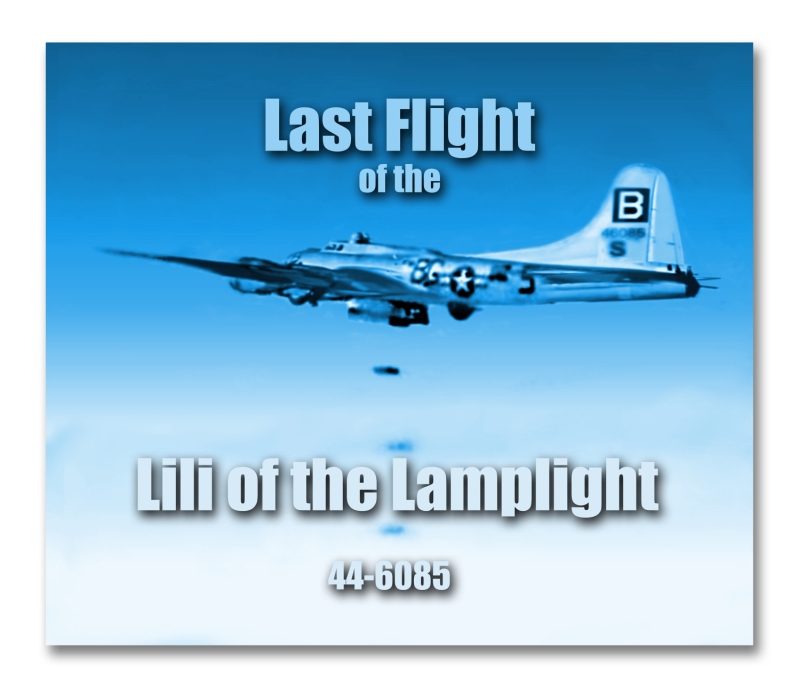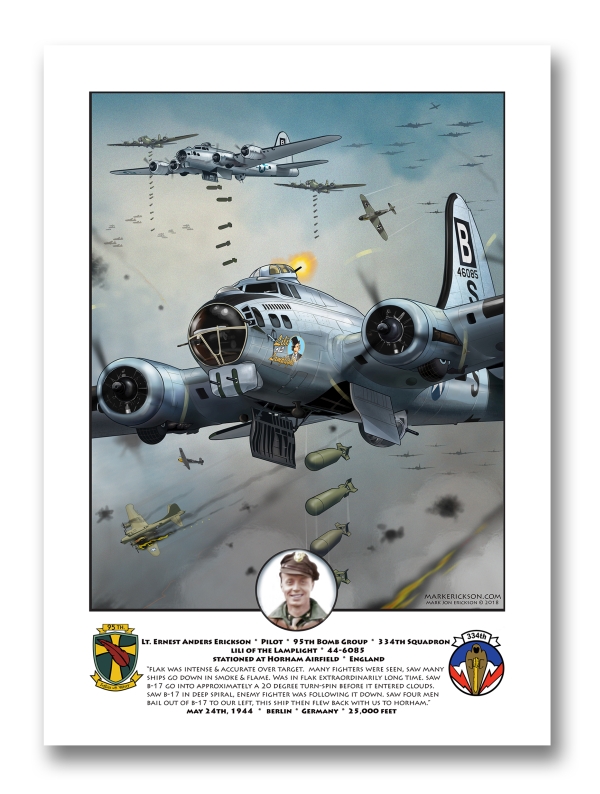|
August 25th, 1944 Politzan der Oder Rechlin/Larz Germany/Poland 
The B-17 my father, Lt. Ernest Anders Erickson of the 95th Bomb Group most identified with as 'their ship' was the 'Lili of the Lamplight,' (44-6085) on which they flew fifteen of their thirty-five missions. Their final mission aboard the Lili, their 34th, was completed on August 12th, 1944. Soon after, my father spent time in and around London, on what is referred to as a 'flak leave.' He was facing his final 35th mission, and it would be two weeks before he would be idling on the Horham (England) Airfield tarmac awaiting take-off for that last combat assignment. Luck was with my father and his crew, aboard the Lili. His stories bare that out as well as the attached article, an interview featured in the Bismarck Tribune on October 5th, 1944. The header of the article states, 'Lili of the Lamplight was Lucky Lady' Pilot Says. My father's mission notes for his 2nd Berlin raid on May 24th, 1944 were easily the most poignant of any of his journal writings. As on most missions, his words mention familiar terms describing a formation's entrance into the dreaded dense flak field of artillery fire. I have read countless recollections of missions by many crewmen and this hits it square on the head.
25,000 feet over Berlin The Lili of the Lamplight had flown a total of twenty five successful missions with the 334th Squadron over German occupied Europe. It had been part of the D-Day Invasion missions, with bombings on targets over Boulogne and Normandy, in the days leading up to June 6th. The ship had taken part in the second shuttle missions in early August of 1944, with raids criss-crossing the span of Europe. With two landings at Poltava Airfield for fueling and bomb reloading in the Ukraine, and on the last mission of four, a landing at Foggia Airfield in Italy. The Lili wore her numbers (44-6085) proud on raids over Munich, Berlin, Merseburg, Germany and Toulouse, France among other cities and targets. As the Lili of the Lamplight stared down it's 26th mission, the next crew that took her out, was not as fortunate as my father's time aboard. His 'Lucky Lady,' was just that. The timing, and the luck of my father's 35 missions brought him home as he mentioned in the article, without a scratch. On August 25th, 1944, thirteen days after my father and crew's 34th mission aboard the 'Lili,' another crew took her on what would be her final and most deadly mission. Lt. Albert Bishop Powell Jr. piloting the Lili of the Lamplight took off from Horham Airfield in England, and headed deep into Europe for a bombing mission over Central Pomerania. The Lili was flying in formation alongside other heavy bombers of the 334th Squadron, towards their ultimate target, the Hydriewerke synthetic petrol factory near Politzan der Oder, a town in a district of today's Poland. Also targeted for the various squadrons were sites near Rechlin/Larz, Germany, where the Germans were developing the Luftwaffe's ME-262 jet. The Messerschmidt Me-262 was nicknamed 'Schwalbe,' or 'Swallow' in English, it was the fighter version, the 'Sturmvogel' or 'Storm Bird,' and was a powerful fighter-bomber model. The Me-262 was the first operational jet-powered fighter. Design work started in the mid-late 1930s, but engine problems and Hitlerís interest in bomber production kept the aircraft from operational use with the Luftwaffe until mid-1944. A very fortunate decision for the 8th Air Force as it turned out.
Chuck Yeager is quoted as saying: The 334th approached their targets as 'flak' bursts in and around the formation began to increase. Soon enough they found themselves in a highly concentrated 'flak' field. Ships in the formation were taking hits, one ship dropped out of formation and another was seen in a sharp downward spiral. Things aboard the Lili were beginning to go bad, when it withstood multiple bursts of artillery fire. Two engines began to sputter and smoke was trailing, as the ship's speed and altitude was deteriorating. The Lili of the Lamplight fell out of formation. The pilots attempted to evade the flak bursts by pulling out of formation and turning right. As the Lili arced for that turn it took a direct hit to the No. 3 engineís fuel tank. A massive explosion sheered off a large part of the wing and the ship was in serious trouble. Controls now were becoming useless, and the ship went into a free-fall. The pilots and crew were hopelessly fighting to correct catastrophic problems throughout the ship. In the final moments, the men began to bail out, while the ship was spiraling out of control, beginning a rapid descent. The Lili was splitting apart and in it's last seconds violently hurtled into the woods near the villages of Schwankenheim, Wolfshorst and Schwabacht. The ship crashed eight miles outside of Szczecin, Poland, some seventy-five miles from where the ship first came under-fire. Three crew members including a 95th Bomb Group photographer were killed. Over the next three days, the other seven crewmen were captured by the Germans, spending the duration of the war in a POW camp. The first-hand reports of the crew's interrogation by the Luftwaffe give a vivid account of what happened onboard during those last minutes of the mission. Four of the survivors, including pilot Albert Bishop Powell Jr., Waist Gunners Staff Sgt. Eldred W. Steffens, Staff Sgt. Henry W. Schneider and Radio Operator Staff Sgt. Peppe J. Delio gave unnerving testimony describing this last mission of the 'Lili of the Lamplight.' Their words are direct and purely surreal.
Waist Gunner Staff Sgt. Eldred W. Steffens said:
Radio Operator Staff Sgt. Peppe J. Delio stated:
Waist Gunner Staff Sgt. Henry W. Schneider recalled:
Pilot Albert Bishop Powell Jr. gave this chilling final report: Powell, the Co-Pilot Lt. Connor and the Navigator Lt. Overdorff all bailed out soon after this conversation. And in the culmination of that frightful experience, the end of my father's 'Lucky Lady,' came to be. He never talked of this particular part of the story, but talked as if the ship were still flying and his memories were strong in how the 'Lili of the Lamplight' took them to their targets and always got them home safely. Intense moments abroad the Lili no doubts, but his thoughts were on how he was able to successfully complete his 35 missions and live to tell about them. These passages opened my eyes to the dangers my father faced every time he took off from Horham and headed east over Nazi occupied Europe. Today, we can look back on those missions as seen through the jittery lens of an onboard gun camera, or the newsreel footage originally shown in movie houses during the war. Those films tell the story in black and white. The words of the crew members, describing their final moments aboard an airplane spiraling uncontrollably toward the ground, appear in real fictionally sounding color. Perhaps more vividly these words describe the terrifyingly real dangers which faced the bomber crews on every mission.
The crew of the Lili of the Lamplight's final mission on August 25th, 1944 |

